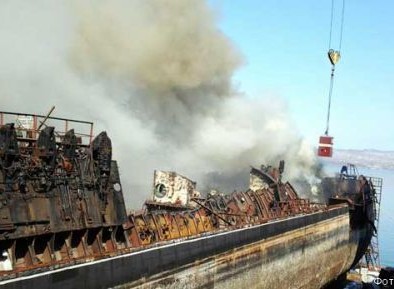
New Managing Director for Bellona Norway
The Board of the Bellona Foundation has appointed former Minister of Climate and the Environment Sveinung Rotevatn as Managing Director of Bellona No...
News

Publish date: May 1, 2016
Written by: Charles Digges, Anna Kireeva
News
A decommissioned Russian nuclear submarine moored off a naval base on the Kamchatka peninsula caught fire on Friday, but there was no radioactive contamination because its nuclear fuel had already already been removed, Russian media reported.
The Russian Ministry of Defense announced the blaze on April 29, saying that the Krasnoyarsk Project 949 submarine was being disassembled in Vilyuchinsk on Kamchatka when its rubber-coated outer hull caught fire.
The fire, concentrated in the bow section, burned for about three hours before it was extinguished by Russian Ministry for Emergency Services, the Interfax newswire reported. The agency reported the fire was stifled without having to submerge the submarine, as some earlier reports had indicated.
 The Krasnoyarsk aflame. (Photo: Kam24.ru)
The Krasnoyarsk aflame. (Photo: Kam24.ru)
Valery Kosykh, head of environmental monitoring at Russia’s Federal Information and Analysis Center, told Interfax in an earlier report that specialists “have not recorded any changes” in background radiation levels in Vilyuchinsk.
“Before the vessel was sent for dismantlement, all weapons systems were removed,” a release from the Russian Ministry of Defense, cited by RIA Novosti, read. “The reactor section had been removed. There is not danger to the environment.”
The Krasnoyarsk submarine, an Oscar-I class nuclear-powered submarine, was built in 1983 and launched in 1986 as part of the Soviet Union’s Pacific Fleet. It left service in 1998.
On whole, 40 percent of the vessel had been dismantled when Friday’s blaze broke out, Andrei Malovik, head of the Northeast Repair Center, where the Krasnoyarsk is moored, told the agency.
 Russia's Ministry of Emergency Services hoses down the burning rubber hull of the Krasnoyarsk. (Photo: Kam24.ru)
Russia's Ministry of Emergency Services hoses down the burning rubber hull of the Krasnoyarsk. (Photo: Kam24.ru)
“Such fires sometimes happen during dismantlement,” said Malovik. “This one occurred in the bow section in a hard to reach area, was extinguished, they poured water on it, all was localized and there’s no danger.”
He added that submarines contain numerous flammable components that assure the vessel’s stealth.
But such fires seem to happen with unusual frequency at shipyards owned by the Russia’s state owned United Shipbuilding Corporation, which is a co-owner of the Northeast Repair Center, according to its website.
“This emergency is another reminder that the process of dismantling decommissioned subs doesn’t always go smoothly,” said Nils Bøhmer, Bellona’s executive director. “There must be an independent investigation of the fire in order to ensure more safety in future dismantlement operations.”
United Shipbuilding Corporation seems especially flammable
Then-Russian President, now Prime Minister, Dmitry Medvedev, called for a government investigation of the United Shipbuilding Corporations dismantlement operations after a particularly dramatic dismantlement fire at the Roslyakovo shipyard, owned by the United Shipbuilding Corporation, in Russia’s Northwest in 2011.
 The Yekaterinburg nuclear submarine ablaze in 2011.
Credit: Blogger51
The Yekaterinburg nuclear submarine ablaze in 2011.
Credit: Blogger51
The fire, which was blamed on careless welding works, severely injured 19 workers.
Results of the investigation have not been made public.
The Yekaterinburg submarine had put into Roslyakovo for short-term repairs. Bellona’s investigation later determined the submarine’s nuclear missiles had been onboard during the nine-hour blaze that was only extinguished by submerging the sub. The government later admitted this was the case.
Surprisingly, after extensive repairs at the Zvedozdochka Shipyard near Arkhangelsk, the Yekaterinburg was released for active duty in 2014.
The latest fire on the Krasnoyarsk brings to five the number of dismantlement fires that have broken out at United Shipbuilding Corporation owned shipyards since 2011.
In April 2015, the Orel, an Oscar-II class vessel which was undergoing repairs also at Zvezdochka, caught fire. The sub reportedly had to be submerged to extinguish the blaze. Again, careless welding practices were blamed.
 Smoke rising from the Zvezdochka shipyard as the fire on the Orel rages on. (Photo: Flashnord)
Smoke rising from the Zvezdochka shipyard as the fire on the Orel rages on. (Photo: Flashnord)
In March 2014, the Krasondar nuclear submarine caught fire during dismantlement at the United Shipbuilding Corporation’s Nerpa Shipyard. There were no radiation dangers, as the Krasnodar’s spent nuclear fuel had been offloaded.
In September 2013, a fire broke out on the Tomsk nuclear submarine, like the Kransoyarsk, a Pacific Fleet sub, at the United Shipbuilding Corporation’s Bolshoi Kamen near Vladivostok. The circumstances were similar to that of the Yekaterinburg fire: A gas powered saw used to cut through a grate set the vessel’s worn rubber covering, cables and paint on fire.
Investigators later admitted 15 workers had been injured after reporting no one had been hurt.
Prior to 2011, the United Shipbuilding corporation’s Zvezdocka saw four other accidents and fires between 2005 and 2009.

The Board of the Bellona Foundation has appointed former Minister of Climate and the Environment Sveinung Rotevatn as Managing Director of Bellona No...

Økokrim, Norway’s authority for investigating and prosecuting economic and environmental crime, has imposed a record fine on Equinor following a comp...

Our op-ed originally appeared in The Moscow Times. For more than three decades, Russia has been burdened with the remains of the Soviet ...

The United Nation’s COP30 global climate negotiations in Belém, Brazil ended this weekend with a watered-down resolution that failed to halt deforest...